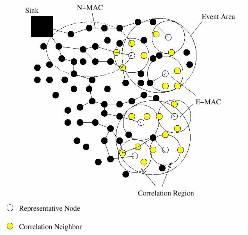Spatial Correlation-based Collaborative Medium Access Control in Wireless Sensor Networks,
M. C. Vuran and I. F. Akyildiz, IEEE/ACM Transactions on Networking, vol. 14, no. 2, pp. 316 -329, April 2006.
 
|

|
Abstract:
Wireless Sensor Networks (WSN) are mainly characterized by dense
deployment of sensor nodes which collectively transmit information
about sensed events to the sink. Due to the spatial correlation
between sensor nodes subject to observed events, it may not be
necessary for every sensor node to transmit its data. This paper
shows how the spatial correlation can be exploited on the Medium
Access Control (MAC) layer. To the best of our knowledge, this is
the first effort which exploits spatial correlation in WSN on the
MAC layer. A theoretical framework is developed for transmission
regulation of sensor nodes under a distortion constraint. It is
shown that a sensor node can act as a representative node for
several other sensor nodes observing the correlated data. Based on
the theoretical framework, a distributed, spatial Correlation-based
Collaborative Medium Access Control (CC-MAC) protocol is then
designed which has two components: Event MAC (E-MAC) and
Network MAC (N-MAC). E-MAC filters out the correlation in
sensor records while N-MAC prioritizes the transmission of
route-thru packets. Simulation results show that CC-MAC achieves
high performance in terms energy, packet drop rate, and latency.
|

